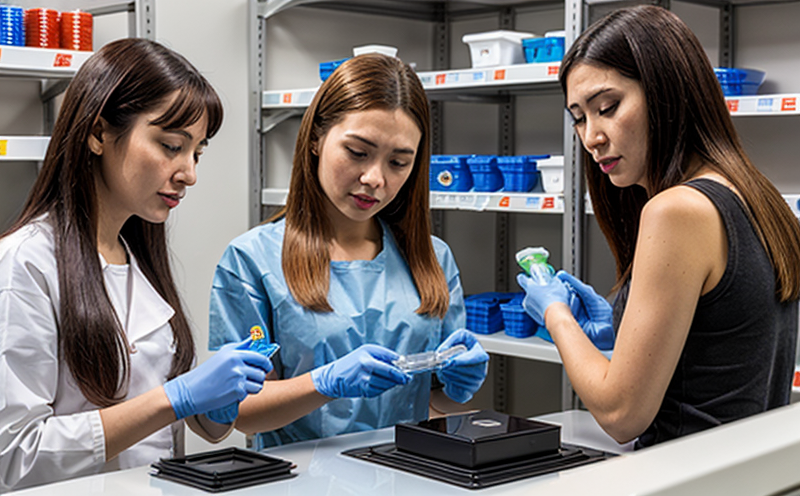SAE J2027 Automotive Consumer Plastic Testing
The SAE J2027 standard is a critical tool in the automotive industry, designed specifically for testing consumer plastics used in automotive components. This service ensures that materials meet stringent performance requirements to enhance safety and durability of vehicles. The SAE J2027 protocol covers a range of mechanical properties, chemical resistance, and environmental stress cracking tests essential for quality assurance.
Automotive consumer plastics are subject to numerous stresses during vehicle operation, including thermal cycling, exposure to fuels, oils, and other chemicals, as well as UV radiation. To ensure that these materials perform reliably over the lifecycle of a vehicle, SAE J2027 provides a comprehensive set of testing methodologies.
The standard is particularly relevant for plastic components like interior trim, exterior parts, electrical connectors, and fuel lines. These components must withstand not only mechanical stresses but also environmental factors that can degrade material integrity over time. The SAE J2027 protocol addresses these challenges by offering a series of tests aimed at simulating real-world conditions.
One of the key aspects of this testing involves understanding how different plastics behave under various stressors. For instance, the standard includes tensile strength and elongation at break tests to evaluate the mechanical integrity of plastic parts. Additionally, there are chemical resistance tests that assess a material's ability to withstand exposure to automotive fluids.
Another critical component is the environmental stress cracking (ESC) test. This evaluates how well plastics can resist cracking under combined thermal and stress conditions, which is particularly important for fuel lines and other components exposed to harsh environments. The ESC test simulates a scenario where a plastic part might be subjected to high temperatures while being stretched or flexed.
The SAE J2027 also includes tests related to heat aging, which assesses how well the plastic maintains its properties after prolonged exposure to elevated temperatures. This is crucial for parts that are exposed to engine compartments where temperatures can reach extreme levels. The standard provides specific protocols for conducting these tests and interpreting results.
Moreover, SAE J2027 addresses the issue of creep in plastics—a phenomenon where a material deforms under constant stress over time. This is particularly relevant for components that are subjected to continuous mechanical loads, such as certain types of fasteners or connectors. The standard provides methods for measuring and reporting creep behavior.
Another important aspect of SAE J2027 is the focus on fatigue testing, which simulates the repeated loading and unloading of a plastic part during vehicle operation. This helps identify potential weaknesses in material design that could lead to premature failure. Fatigue tests are crucial for ensuring that critical components like fuel lines and electrical connectors can withstand thousands of cycles without degradation.
For quality managers, compliance officers, and R&D engineers working within the automotive sector, SAE J2027 provides a robust framework for ensuring that consumer plastics meet stringent performance standards. By adhering to this protocol, manufacturers can ensure that their products are not only safe but also durable and reliable.
Industry Applications
| Component Type | SAE J2027 Test Application |
|---|---|
| Injection Molding Parts | Tensile Strength and Elongation at Break Tests |
| Electrical Connectors | Chemical Resistance, Heat Aging, and Creep Testing |
| Fuel Lines | Environmental Stress Cracking (ESC) Tests |
- Injection Molding Parts: These are critical for interior and exterior components, requiring high tensile strength and flexibility.
- Electrical Connectors: Must withstand harsh environmental conditions while maintaining electrical conductivity.
- Fuel Lines: Require resistance to chemical degradation and mechanical stress to prevent leaks and failures.
Environmental and Sustainability Contributions
The SAE J2027 standard plays a crucial role in promoting sustainability within the automotive industry by ensuring that consumer plastics are not only safe but also environmentally friendly. By adhering to this protocol, manufacturers can select materials that minimize environmental impact while maintaining performance standards.
One of the key benefits is reduced waste generation during production and recycling processes. The standard encourages the use of recycled materials without compromising on quality or safety. This not only reduces the need for virgin raw materials but also decreases energy consumption associated with material extraction and processing.
Another significant contribution is in improving fuel efficiency. By ensuring that plastic parts are lightweight yet strong, manufacturers can design vehicles with reduced weight, which directly translates to lower fuel consumption and emissions. This aligns perfectly with global efforts towards reducing carbon footprints of transportation sectors.
The standard also promotes the use of renewable resources where possible, further enhancing sustainability practices within the industry. By encouraging innovation in material sourcing and processing techniques, SAE J2027 supports a greener future for automotive manufacturing.
Competitive Advantage and Market Impact
- Ensures compliance with international standards, enhancing market access globally.
- Positions companies as leaders in quality and reliability, attracting more clients and partnerships.
- Promotes continuous improvement through rigorous testing, leading to better product designs.
The SAE J2027 protocol provides a competitive edge by ensuring that automotive consumer plastics meet the highest standards of performance and safety. Compliance with this standard not only enhances brand reputation but also opens up opportunities for expanding into new markets. By adhering to these stringent testing procedures, manufacturers can differentiate themselves from competitors who may not have access to such comprehensive quality assurance measures.
The protocol fosters innovation by encouraging the exploration of new materials and manufacturing techniques that meet or exceed the specified requirements. This drives technological advancements within the industry, ultimately benefiting both manufacturers and consumers alike.





